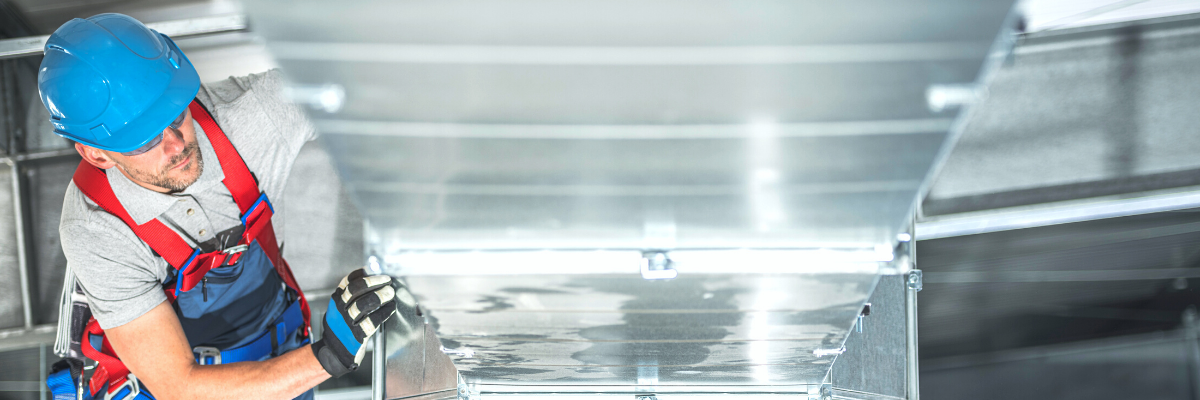Improve Your Indoor Air Quality in Five Steps
Whether your commercial space is open at full capacity or taking a phased approach to welcoming workers and the public, indoor air quality is likely top of mind for everyone in your organization.
Indoor air quality is an important factor in keeping workers and customers safer and more comfortable in our post-pandemic world.
Although we don’t have definitive proof that COVID-19 can be spread via HVAC systems, there is evidence to suggest it can happen. According to guidance from the American Society of Heating, Refrigerating and Air-Conditioning Engineers (ASHRAE), transmission through the air of COVID-19 is “sufficiently likely that airborne exposure to the virus should be controlled.”
But how should commercial properties approach indoor air quality improvements? A good place to start is with the following clear, actionable steps, backed up by expert guidance from the EPA, CDC, and ASHRAE.
The list below not only helps improve the work environment and mitigate certain risks, it can help manage – or even reduce – operations costs. All of these are urgent priorities for commercial property managers and owners.
FIVE STEPS TO HELP IMPROVE INDOOR AIR QUALITY
1. GIVE YOUR HVAC SYSTEMS A THOROUGH CHECK-UP
Even before the COVID-19 pandemic, we knew that indoor air quality has a direct effect on our health.[1] In addition to communicable diseases, pollutants such as mold or dust can impact health in your workspace.
Make sure all HVAC systems are operating properly and comply with ASHRAE ventilation requirements.[2] A properly maintained HVAC system is the foundation of better indoor air quality across your properties. Routine HVAC maintenance might not sound exciting, but without timely check-ups, your system could be using too much energy, or pollutants could become trapped in your system.
Moisture, of course, is often a by-product of an improperly maintained HVAC system as well. That moisture can foster the growth of mold and mildew, and may even give viruses (like COVID-19) the opportunity to remain viable for a longer period of time.
Especially if your building was closed or not fully utilized for a few months, it’s a good idea to have ductwork inspected and cleaned now. Ask your commercial cleaning and maintenance partner to share recommendations and expertise.
2. CONSIDER HIGH-EFFICIENCY FILTERS TO IMPROVE AIR QUALITY
We know high-efficiency filters (such as HEPA or high-level MERV filters) can significantly reduce concentrations of indoor airborne particles. They can filter dust and other pollutants – and it’s possible they may filter out some virus particles.[3] High-efficiency filters aren’t a silver bullet, since some COVID-19 particles may still pass through, but they play an important role in your overall indoor air quality program.
Of course, this is only when those high-efficiency filters are properly maintained. Your HVAC maintenance program should include preventive maintenance (as well as corrective repairs) to ensures filters are installed the right way, working properly, and are within their service life.
3. CONSIDER UV AIR-CLEANING PRODUCTS
Another move toward better indoor air quality may include the use of ultraviolet (UV) disinfection technology.
According to ASHRAE, “the entire UV spectrum is capable of inactivating microorganisms, but UV-C energy (wavelengths of 100 – 280 nm) provides the most germicidal effect.”[4]
You can implement UV disinfection technology in a variety of ways, including:
- Banks of UV lamps installed inside HVAC systems or ductwork
- Banks of UV lamps focused on drain pans, cooling coils, and other moisture-rich surfaces inside HVAC systems
- UV fixtures mounted to the wall or ceiling in occupied spaces
Like the high-efficiency filters, UV technology isn’t a guaranteed solution, but is another useful component in your overall indoor air quality plan.
4. LAUNCH AN INTEGRATED DISINFECTING PLAN
An integrated disinfecting plan works hand-in-hand with your indoor air quality plan. Work with a reputable facility services provider to develop, launch, and maintain efficient, regular cleaning of frequently touched surfaces in your workspace, such as handrails, light switches, and doorknobs.
Make sure your facility services provider trains its team members on social distancing, PPE use, and EPA-approved products for use against the virus that causes COVID-19.[5]
The right team also will create a tailored service plan that addresses your unique physical environment – one that can be adjusted if your onsite population fluctuates.
5. LET YOUR TENANTS AND WORKERS KNOW ABOUT YOUR EFFORTS TO IMPROVE AIR QUALITY
A clear communications plan helps everyone feel more confident and comfortable in your workspace.
As you build out a communications plan, stay connected with your commercial cleaning partner. You should feel comfortable asking questions and having conversations with your provider to ensure your priorities are understood and achieved.
Workers, vendors, and customers will appreciate an open, steady flow of information from you about the steps you’re taking to creating a cleaner, healthier environment by improving indoor air quality.
FIND OUT HOW CLEAN-TECH CAN HELP
To learn more about how Clean-Tech helps commercial properties by cleaning for health as well as appearances, contact one of our professionals at info@cleantechcompany.com.

